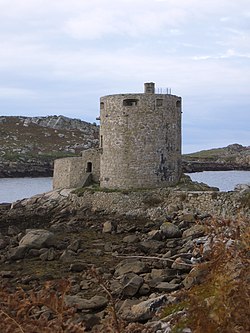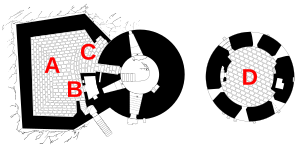Cromwell's Castle
| Cromwell Castle | |
|
Cornwall | |
|---|---|
 Cromwell's Castle | |
| Type: | Gun tower |
| Location | |
| Grid reference: | SV881159 |
| Location: | 49°57’44"N, 6°20’58"W |
| History | |
| Built 1651, 1739 | |
| Information | |
| Owned by: | Duchy of Cornwall (in the care of English Heritage) |
Cromwell's Castle is a 17th-century fortification known as a blockhouse on the island of Tresco in the Isles of Scilly, Cornwall. It was built after the invasion of the Isles by Sir Robert Blake in 1651. It was further expanded in 1739 during the War of Jenkins' Ear.
History
Cromwell's Castle is a coastal gun tower built by Sir Robert Blake following the Parliamentary invasion of the Isles of Scilly in 1651.[1] During the Civil War between 1642 and 1646, the Isles had been held by Royalist supporters of King Charles I, and rebelled against Parliament in favour of Charles in 1648.[1] Tresco became a base for Royalist privateers and Parliament became concerned that the Dutch, then hostile to England, might exploit the situation.[2] In 1651 Parliament sent Robert Blake and a naval force to retake the island.[1]
Having re-established control, Blake constructed Cromwell's Castle, named after Oliver Cromwell, the Parliamentary leader. The existing fort, King Charles's Castle, had been built in the 1550s but was poorly sited and had been largely blown up by its defenders when Blake's forces took the island.[3] The castle comprised a two-storey tower, 20 feet wide and 50 feet high, with walls 13 feet thick.[2] Six gun-ports allowed the battery a good angle of fire across the channel between the islands of Bryher and Tresco.[2]
In 1739 the War of Jenkins' Ear broke out between Britain and Spain, and the decision was taken to improve the defences at Cromwell Castle.[4] A large gun-platform for a battery of six guns was built to the south-west of the tower, and other improvements were made.[2]
The fortress today
In the 21st century, the castle is controlled by English Heritage and operated as a tourist attraction. It is protected as a Grade II* listed building.
Outside links
| ("Wikimedia Commons" has material about Cromwell's Castle) |
- Cromwell's Castle – English Heritage
References
- ↑ 1.0 1.1 1.2 Bowden, & Brodie 2011, p. 9
- ↑ 2.0 2.1 2.2 2.3 Cromwell's Castle: History and research
- ↑ Bowden, & Brodie 2011, p. 9; Cromwell's Castle: History and research - English Heritage Historical information
- ↑ Bowden, & Brodie 2011, p. 10
- Bowden, Mark; Brodie, Allan (2011). "Defending Scilly". Research News (16): 8–11.
- Fry, Plantagenet Somerset (1980). The David & Charles Book of Castles. David and Charles. ISBN 0-7153-7976-3.
